Like stumbling into a scene from an old Western, you’ll find towering saguaros casting long shadows across sun-baked washes. You can drive from Tucson in about 30 minutes, hike quiet trails at dawn, and time your visit for cooler months or spring blooms. This guide walks you through getting there, park districts, top viewpoints, and practical tips so you can plan a smooth, rewarding day—or longer—among the giants.
Quick Tips for Visiting Saguaro National Park
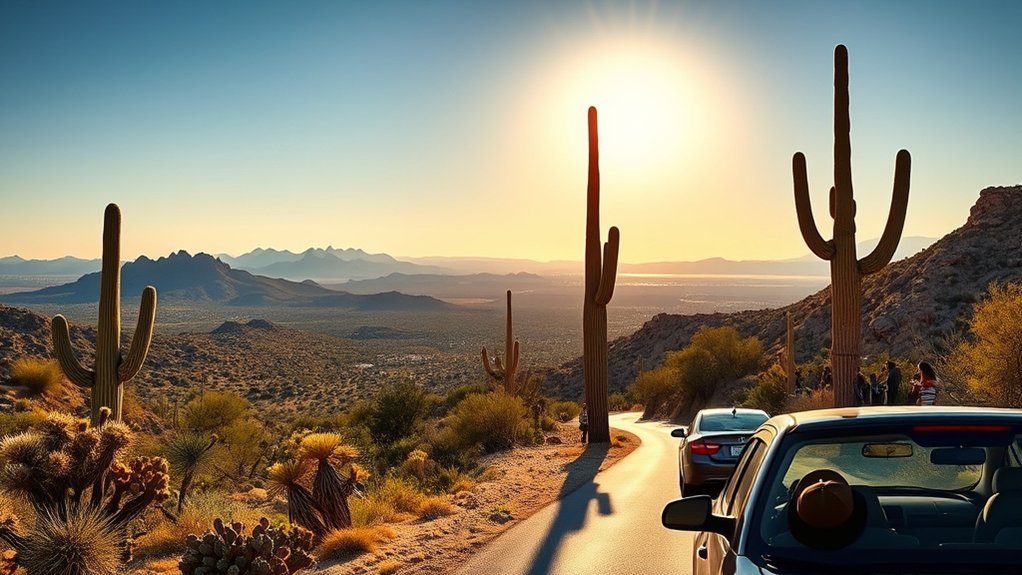
Plan to visit during the cooler months—January through March—when temperatures average about 65°F and hiking is more comfortable, and make sure you’ve got layers, plenty of water, and snacks for any trail. You’ll reach Saguaro National Park easily from Tucson via I-10; the Rincon Mountain (East) and Tucson Mountain (West) districts have clear access routes. Pay the $25 admission per vehicle—good for seven days and both districts—so you can enjoy multiple scenic drives like Cactus Forest Scenic Loop and Bajada Loop Drive. Stop at the visitor center to get maps and current trail conditions. Choose hiking trails suited to your fitness, respect desert landscapes, and plan for temperature variations throughout the day to stay safe and comfortable.
When to Go: Best Seasons and Weather to Expect
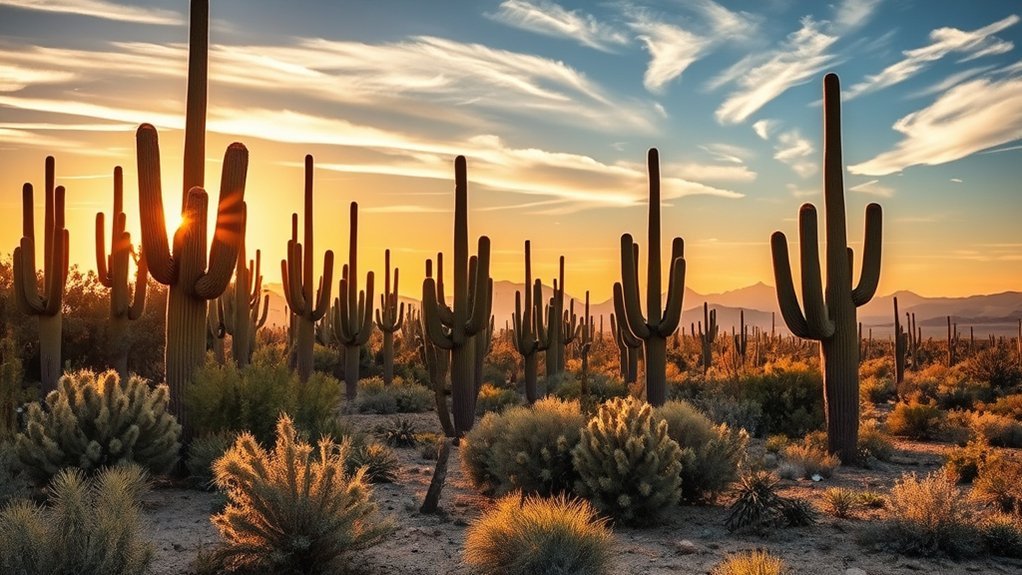
If you want the most comfortable weather and the best chance for long, unrushed hikes, aim for winter and spring—December through May offers mild days (around the mid-60s to 80s°F) and vivid wildflower displays—while summer’s triple-digit heat and early fall’s lingering monsoon risk make midday treks risky. The best time to visit is the winter months (December–February) when temperatures average about 65°F, ideal for outdoor activities and long trail days. Spring brings wildflower blooms and warmer temperatures in the 70s and 80s, though crowds grow. Summer months often exceed 100°F; avoid midday exertion. In fall season you’ll find comfortable temperatures for mornings and evenings, but watch for monsoon storms early on. Cactus blooms peak mid-May to early June, with early June prime viewing when visiting Saguaro National.
How to Get There and Park Layout
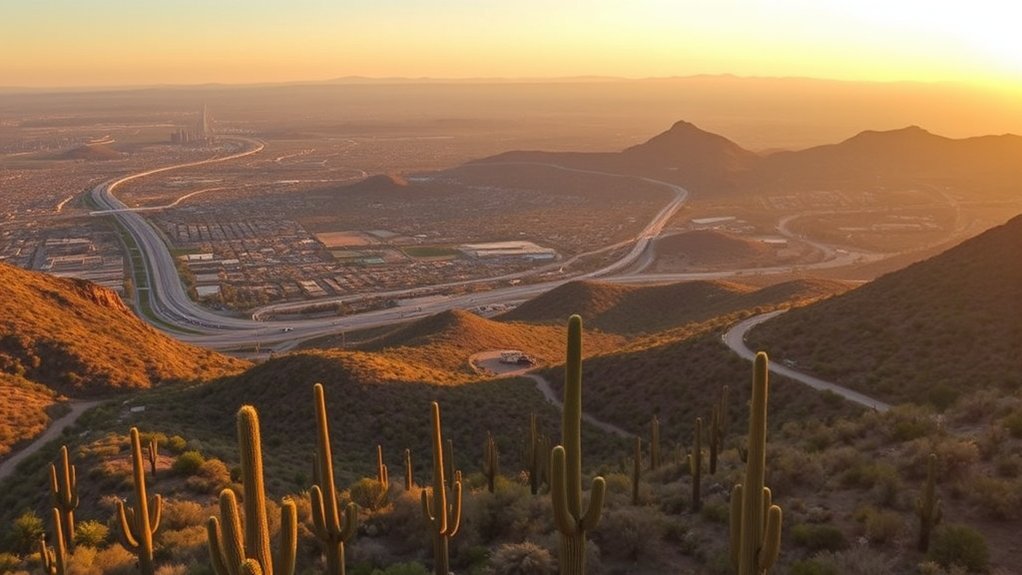
Now that you know when to visit, you’ll want to figure out how to get there and how the park is laid out so you can make the most of your time. Saguaro National Park sits just outside Tucson and is easily reached via I-10; plan about 30 minutes travel time from downtown to either district. The park layout splits into Tucson Mountain District (Saguaro) to the west and Rincon Mountain District (Saguaro) to the east, and it takes roughly an hour to drive between them. Both districts favor scenic drives: explore Cactus Forest Drive in the Rincon and Bajada Loop Drive in the Tucson Mountains. Year-round access varies by district and arrival time, and a single admission covers seven days for both sides.
Entrance Fees, Passes, and Visitor Centers
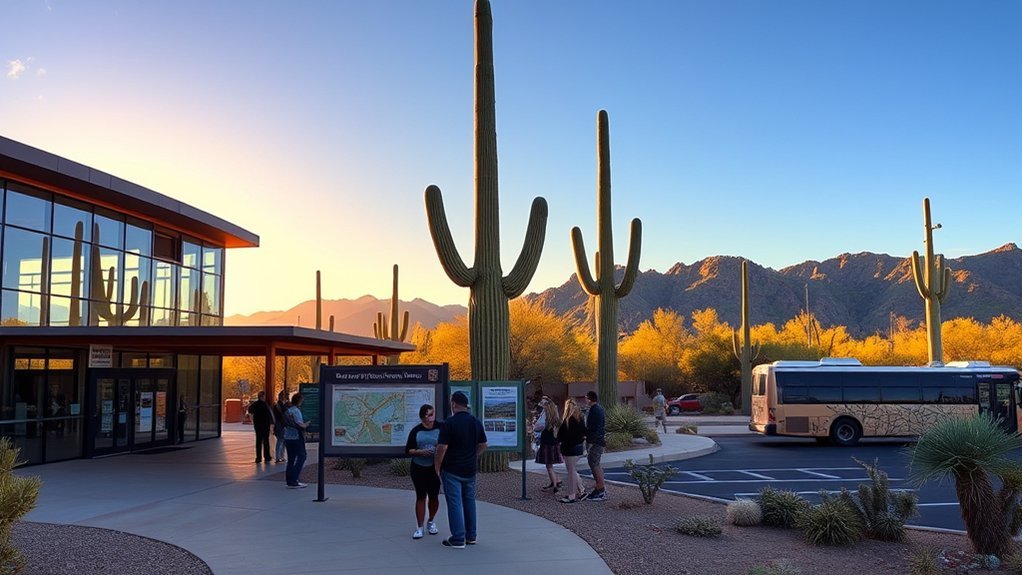
Admission to Saguaro National Park costs $25 per vehicle, $20 per motorcycle, or $15 per person on foot or bicycle, and each ticket is good for seven days at both the Tucson Mountain (West) and Rincon Mountain (East) districts. Pay the entrance fees at kiosks or staffed booths, or use the America the Beautiful pass to cover admission if you have it. Stop first at one of the visitor centers—the Red Hills Visitor Center in the West or the Rincon Mountain Visitor Center in the East—for maps, trail advice, and up-to-date conditions. Rincon Mountain Visitor Center is open daily 9 AM–5 PM except Christmas. Note there are no concessions in the park, so pack ample food and water before you explore the saguaros.
One-Day Itinerary: Top Stops to See
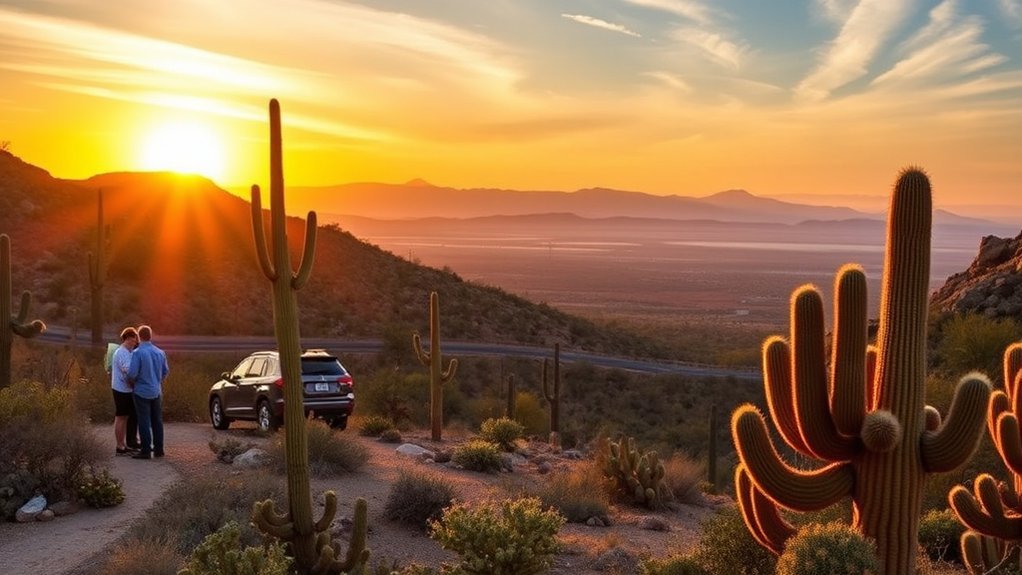
Start your morning with a revitalizing hike—begin at Red Hills Visitor Center for maps, then tackle the Freeman Homestead Trail or the short Valley View Overlook walk to soak in iconic saguaro panoramas. In the afternoon, switch gears to scenic drives: take the Bajada Loop in the west to spot petroglyphs at Signal Hill and the Cactus Forest Scenic Loop in the east for multiple pullouts and wildlife viewing. These choices let you combine crisp desert trails with relaxed, photo-friendly road stops for a full, memorable day.
Morning Hike Highlights
If you want to make the most of a single morning in Saguaro National Park, head into the Rincon Mountain District‘s Cactus Forest Scenic Loop Drive to hop between short hikes and overlooks that showcase the saguaro-studded landscape. You’ll weave an 8-mile loop with pullouts for quick stops and dramatic scenic views. Start easy with the family-friendly Desert Discovery Nature Trail, then take the Valley View Overlook Trail for a 0.8-mile round trip vista. Pause at Signal Hill Petroglyphs to see Hohokam rock art along its 1.1-mile round trip loop. If you’re fit and short on time, finish with a portion of the Wasson Peak route for broad panoramas. Plan your pacing, bring water, and enjoy purposeful hiking.
- Desert Discovery Nature Trail: paved, family-friendly
- Valley View Overlook Trail: 0.8-mile round trip
- Signal Hill Petroglyphs: cultural stop, 1.1-mile round trip
- Wasson Peak: strenuous reward, panoramic views
- Cactus Forest Scenic Loop Drive: easy access, multiple pullouts
Afternoon Scenic Drives
After lunch, take to the park’s scenic drives to cover more ground and soak in sweeping saguaro vistas without wearing out your legs; the Tucson Mountain District’s Bajada Loop Drive and the Rincon Mountain District’s Cactus Forest Scenic Loop together offer a perfect afternoon route with frequent pullouts for quick hikes, photo stops, and picnic breaks. You’ll start on the 6-mile Bajada Loop Drive, pausing at Valley View Overlook for a 0.8-mile round-trip panorama. Visit Signal Hill to study 200+ petroglyphs on a 0.5-mile trail, then cross to Rincon Mountain District for the 8-mile Cactus Forest Scenic Loop with many hiking trails and picnic spots. Finish at Javelina Rocks for prime sunset views and photography.
| Stop | Highlight |
|---|---|
| Bajada Loop Drive | Graded dirt road, pullouts |
| Valley View Overlook | 0.8-mile vistas |
| Signal Hill | Petroglyphs |
| Javelina Rocks | Sunset views |
Must-Do Activities and Hiking Routes
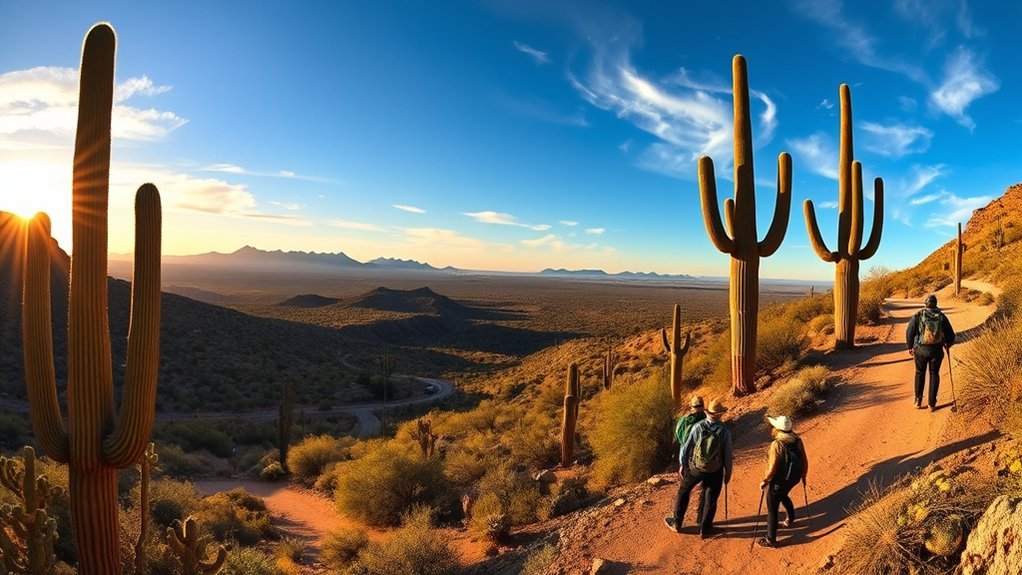
Start with the Bajada Loop Drive in Saguaro West for sweeping desert views and easy access to several trailheads—go counterclockwise to save time. Then lace up for short, rewarding hikes like Valley View Overlook and the Desert Discovery Nature Trail, or opt for the quieter Loma Verde Loop in Saguaro East for a longer, more secluded trek. Don’t miss Signal Hill’s petroglyphs for a quick cultural stop that complements the park’s scenic routes.
Top Trails to Hike
While exploring Saguaro National Park, you’ll find hikes that suit every pace and interest—from short, family-friendly loops to strenuous summit climbs—each showcasing the park’s iconic saguaros, wildlife, and cultural history. Pick your route from these top trails to hike and plan by district—Saguaro West or Rincon Mountain District—to match ability and time.
- Desert Discovery Trail (0.5 mi): an educational, easy walk with interpretive signs for families.
- Valley View Overlook Trail (0.4 mi one-way): short, accessible, stunning saguaro vistas in Saguaro West.
- Signal Hill Petroglyphs Trail (1.1 mi rt): see over 200 Hohokam rock carvings—rich in history.
- Loma Verde Loop Trail (3.8 mi): diverse flora and fauna; ideal for nature lovers in Saguaro East.
- Wasson Peak (8 mi rt): strenuous summit hike with panoramic rewards.
Scenic Drives & Views
If you’ve soaked up the trails, take to the roads and overlooks to see the saguaros from a different angle—slow, scenic drives and short vista hikes let you cover more ground and catch those picture-perfect moments. Drive the Bajada Loop Drive in the Tucson Mountain District for a gentle 6-mile dirt loop through dense cacti, or head to the Rincon side for the 8-mile one-way Cactus Forest Loop Drive with over ten pullouts and viewpoints. Stop at the Visitor Center in Saguaro (East and West) to orient yourself, then hike the 0.8-mile Valley View Overlook Trail for sweeping desert views or the 1.1-mile Signal Hill Trail to see ancient petroglyphs. End at Javelina Rocks Overlook for sunset.
Where to Stay, Eat, and Charge Your EV
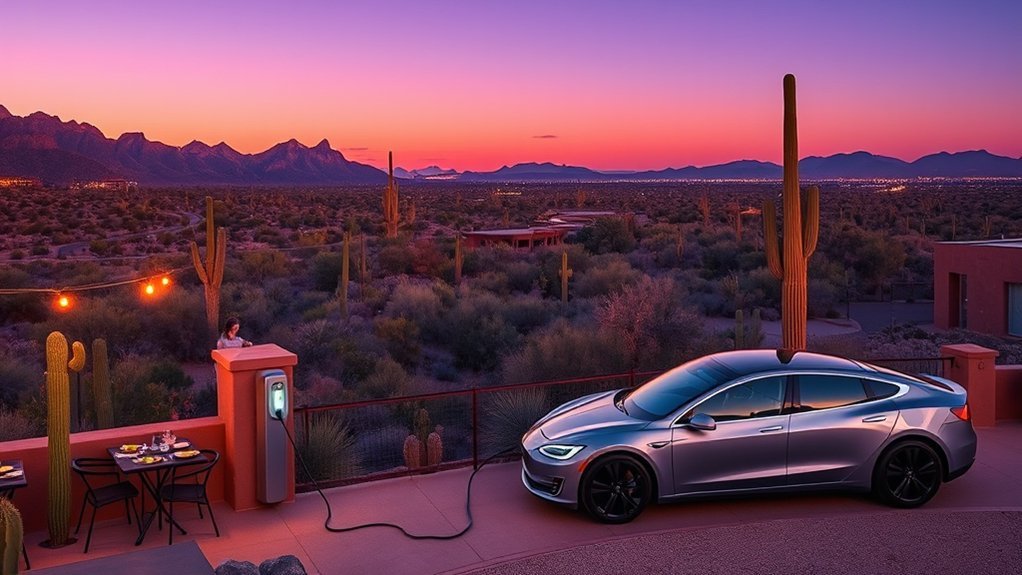
Wondering where to base yourself for a visit to Saguaro National Park? You’ll find Tucson offers the best mix of where to stay, dining options, and practical services. There are no accommodations inside the park, but options like JW Marriott Tucson Starr Pass Resort and Adobe Rose Inn put you 20–30 minutes from either district. Gilbert Ray Campground near Saguaro West provides affordable camping with water and restrooms; backcountry permits cover Saguaro East. There are no dining options in-park, so bring snacks and plenty of water. EV drivers: charging stations aren’t at park entrances, but you’ll find chargers off I-10, on Ina Road, and at many downtown Tucson hotels.
- Stay near Tucson for convenience
- Reserve campground spots early
- Pack snacks and water
- Plan EV charging off-site
- Choose accommodations with on-site amenities
What to Pack and Safety Tips for the Desert
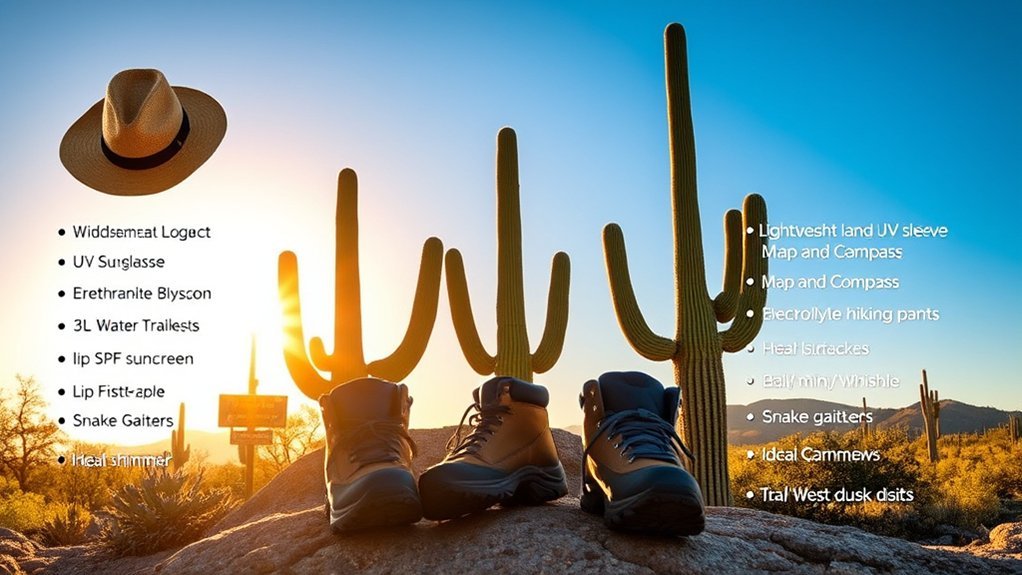
Because desert weather changes fast and trails can be remote, pack deliberately: bring 2–3 liters of water per person (more in summer), high‑energy snacks and electrolyte packets, layered breathable clothing, and sturdy closed‑toed shoes with good traction for rocky terrain. You’ll want water jugs for basecamp, hydration bottles for hiking, lightweight clothing for midday heat, and warmer layers for temperature fluctuations at dusk. Carry a personal locator beacon if you’ll venture off main trails. Follow basic safety tips: tell someone your route, stay on marked paths, and pace yourself in the desert environment.
| Item | Purpose | Tip |
|---|---|---|
| Water jugs | Basecamp hydration | Refill before you go |
| Snacks | Energy on trail | Bring electrolyte packets |
| Shoes | Traction on rocks | Choose sturdy closed-toed shoes |
| Beacon | Emergency recovery | Use for backcountry hiking |
Frequently Asked Questions
What’s the Best Way to See Saguaro Park?
Explore both districts by car, then hike key hiking trails and join guided tours; use photography spots and stargazing locations, enjoy wildlife viewing, park amenities, visitor center, ranger programs, learn cultural history and consider camping options.
How Much Time Does It Take to See Saguaro National Park?
Plan for at least one full day per district, though you can squeeze both with strict time management. You’ll enjoy hiking trails, wildlife observation, photography tips, visitor centers, guided tours, seasonal variations, family activities, park accessibility, and park regulations.
Is There a Scenic Drive Through Saguaro National Park?
Yes — you’ll drive the Bajada and Cactus Forest loops for scenic viewpoints, park photography, wildlife watching, desert landscapes and sunset views; you’ll find hiking trails, a visitor center, cultural history exhibits, park accessibility info and desert flora.
What Places Should I See in Saguaro National Park?
See the Valley View Overlook, Signal Hill, Cactus Forest Loop, Bajada Loop, and Desert Discovery — you’ll admire Saguaro cactus, iconic landscapes, great photography spots, hiking trails, wildlife viewing, visitor center, guided tours, ranger programs, and sunset views.
Conclusion
You’ll plan for mild winters and spring wildflowers, only to find the saguaros already stealing the spotlight—exactly what you came for. Drive in from Tucson, hike a short ridge at sunrise, and let the silent giants teach you patience. Bring water, respect the desert, and charge your EV before you go. You’ll think you’re checking boxes, but the park quietly rearranges your priorities—slowing you down becomes the trip’s best reward.

